Discover the government’s Lifeline program, offering discounted smartphones and monthly minutes to qualifying low-income households. Part of the Affordable Connectivity Program, Lifeline ensures affordable access to communication and internet.
What Are Discounted Government Cell Phones?
Discounted government cell phones are offered through the Lifeline program, a federal initiative that provides low-income households access to free or reduced-cost cell phones and monthly service. This initiative is part of the Affordable Connectivity Program (ACP), which aims to bridge the digital divide by making communication more affordable for individuals and families facing financial hardship.1
Through the Lifeline program, qualifying individuals can receive a smartphone with a certain number of free monthly minutes, texts, and data, helping them stay connected for work, healthcare, and other essential services. Eligibility is generally based on income, or participation in other federal assistance programs such as Medicaid, Supplemental Nutrition Assistance Program (SNAP), or Federal Public Housing Assistance.
The program is particularly important for helping underserved communities maintain access to important services, emergency contacts, and employment opportunities. Several carriers partner with the government to provide discounted services, including companies like SafeLink Wireless, Q Link Wireless, and Assurance Wireless.
The goal of the Lifeline and ACP programs is to ensure that access to basic communication tools is available to all, regardless of income, making it easier for individuals to navigate their personal and professional lives.
Lifeline Program Details
To qualify for the Lifeline program, individuals must meet certain eligibility criteria. These criteria include participation in specific government assistance programs such as Supplemental Nutrition Assistance Program (SNAP), Medicaid, Supplemental Security Income (SSI), Federal Public Housing Assistance, or Veterans Pension and Survivors Benefit. Alternatively, individuals can qualify based on their income, which must be at or below the federal poverty guidelines. The Lifeline program provides a smartphone to eligible individuals, along with a set number of monthly minutes for phone calls. The specific number of minutes may vary depending on the state and service provider.2
In addition to the discounted smartphone and monthly minutes, the Lifeline program also offers discounts on broadband internet service. This can significantly reduce the cost of home internet access for qualifying households, making it more affordable for them to stay connected.
Additional Lifeline Perks
Beyond providing discounted smartphones and internet services, the Lifeline program offers a range of additional perks that can significantly enhance its value for eligible participants. These perks are designed to not only ensure connectivity but also to open doors to broader opportunities.
- Access to Educational Resources: Lifeline partners with various organizations to provide participants access to online educational tools. This includes free or low-cost digital literacy training and resources for continuing education. For students or those seeking further education, having a stable internet connection and a smartphone can be a game-changer in accessing online courses, learning platforms, and study materials.
- Job Training Programs: Many Lifeline providers collaborate with job placement and training programs, helping individuals gain new skills and increase employability. Free access to online job search engines, résumé-building tools, and career training resources means participants can more effectively search for jobs and improve their career prospects.
- Healthcare Services: Lifeline users may also gain access to healthcare resources through partnerships with telehealth platforms, ensuring that individuals have easier access to medical consultations, mental health services, and health information. Reliable communication tools make it easier to stay on top of medical appointments, medication reminders, and emergency services.
By taking advantage of extra benefits, Lifeline participants can improve their educational standing, job prospects, and health outcomes. These additional services help bridge the gap in accessibility, empowering individuals to enhance their quality of life through technology and connectivity.
Learn More About Government Cell Phones
The Lifeline program is a valuable resource for low-income households seeking affordable communication options. By providing smartphones, monthly minutes, and discounted internet service, the program helps bridge the digital divide and empowers individuals to stay connected. Learn more about the Lifeline program and determine your eligibility, you can visit the official website or contact your local service provider.
